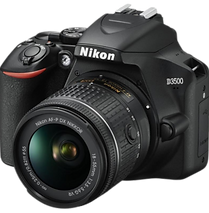
CAMERAS


We use digital single lens reflex (DSLR) cameras for our workshops and the 'Borrow a camera' programs. Our current inventory includes Canon 3000Ds, Nikon D3500s, Nikon D3300s and Nikon z5 Mirrorless. Some of these have been generously donated to us by Timescapes.
Both the Nikon D3500 and Canon 3000D which were released in 2018 have excellent standard lenses that come with the camera, and the image sensors are very good (~23 megapixels). The quality of the lens and sensors make a huge difference to the images. The captures come out very sharp, the colours are excellent and you have the capability to enhance them further in Adobe Lightroom. Images from these cameras print fabulously for exhibitions (11 inch x 14 inch prints) and in our biannual magazines.
DSLR cameras are known for their optical viewfinders, which give you a true picture of the scene that you’re shooting. Students enjoy the analog experience of an optical viewfinder that let's you see what you are capturing and find details and composition of interest. They love the depth of field controls that the cameras allow them to choose. DSLR cameras are traditionally known for their excellent ergonomics and accessible controls, which make them easy and comfortable for learners to handle. This makes them a good choice for beginners who want a camera that’s easy to carry around, with many featuring among the best travel cameras. They are the perfect tool to channel your creativity.
Mirrorless cameras utilise electronic viewfinders and/or touchscreens for visualisation and framing purposes. The newer and more expensive models have improved sensors with higher resolution, higher dynamic range, better autofocus via AI (good for birds, sports, action), and better quality in low light conditions with higher max ISO and noise reduction through AI. However, mirrorless cameras provide an indirect/digital view of reality as you are looking at a screen when capturing an image. As the artist, you may not connect as deeply with the subject and not enjoy the experience.
Phone cameras are good for on-the-go images as they are always with us. They take good images of what the eye can see (e.g. people, landscapes) that are easy to share with others. The ergonomics are not good as you have keep it at a distance from your eyes to be able to see the screen to take an images. Their sensors are much smaller (e.g iPhone 14 sensor is 12.4% of a full frame sensor) and lower megapixels (~12 mp). The images will look good on the small screen of a phone but as you start to see them on larger screen or print them for exhibitions, the detail will not match that of DSLRs and Mirrorless cameras. Their Zoom capabilities don't match interchangeable lens system (e.g. for bird photography) and many of the creative features available on DSLRs and Mirrorless cameras are not be available on phones.


